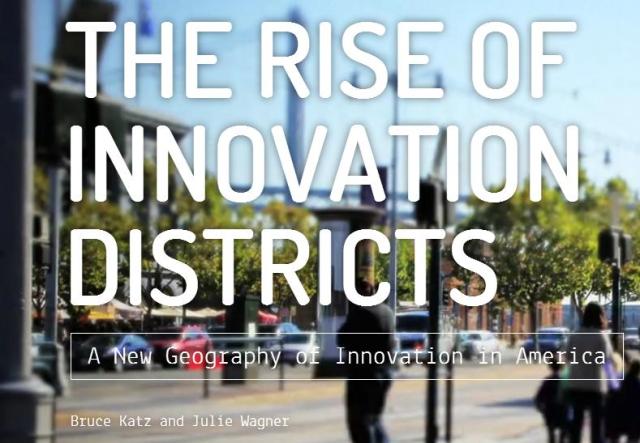I went to a really interesting talk recently in London given by Bruce Katz (@bruce_katz) from the Brookings Institute hosted by the Centre for London. He talked about his report ‘The Rise of Innovation Districts: A New Geography of Innovation in the USA co written with Julie Wagner (@wagnerjk).
These Innovation Districts are urban centres where innovative firms are increasing locating often around anchors such as University research centres. He outlined how out of town research/business parks increasingly were no longer as successful as companies were choosing to locate within cities. He quoted examples such as South Boston Waterfront and downtown and midtown Detroit.
Why is this happening in the US and is it happening here in the UK. He put this down to a number of factors. Down to the nature of the economy where new technologies are driving change across established sectors so there is a need to engaged across sectors and the best place for this is in cities; down to the fact that many large companies now rely a lot more on open innovation drawing inspiration from a network of firms rather than previously large in house research facilities and finally he put it down to how demographics was changing the USA with the nuclear family of 2 kids families based in the suburbs are not where demographic growth is happening. This family unit is a declining share of households. Households especially millenials are increasingly choosing to locate in the centre of cities and firms follow their workers.
So this is a trend but it is a trend supported by policy makers and Mayors who see the real benefits of supporting this.
He outlines the assets that this approach has; into three broad categories.
Economic Assets: these are the firms, institutions and organisations that drive, cultivate or support an innovation rich environment
Physical Assets: are the public and privately owned spaces-buildings, open spaces, streets and other infrastructure – designed and organised to stimulate new and higher levels of connectivity, collaboration, and innovation.
Networking Assets: are the relationships between actors-such as between individuals, firms, and institutions- that have potential to generate, sharpen, and/or accelerate the advancement of ideas.
Each district has differing combinations and weights of these assets
He outlined how policy makers can support the development of these districts based on talking to practitioners working to support these and it is clear that they view this as not only a USA phenomenon as they quote examples from Europe; namely Stockholm; Barcelona and Eindhoven which are known leaders in innovation.
As part of the research they talked to practitioners in
- University City in Philadephia
- Cortex in St. Louis
- Kendall Square in Cambridge
- South Boston waterfront
- Downtown and midtown Detroit
- South Lake union in Seatle
- The Texas Medical Centre in Houston
- 22@Barcelona,
- Stockholm Life and Kista City
- Eindhoven
The article splits how policy makers can support these districts into five linked approaches
- Build a collaborative leadership network – that cooperate on the design delivery, marketing and governance of the district
- Set a vision for growth – which sets out how to grow the district
- Pursue talent and technology – on how to attract talent and how to integrate technologies
- Enhance access to capital – providing a road map for private, civic and public sector investment
- Promote inclusive growth – focussing on the disadvantaged often bordering these areas to up their skills and engagement.
There is far to much detail in this article to cover in this post and so I would wholeheartedly recommending reading it …download from here.
So how does this apply to the UK. Well some of these trends have been apparent in our major cities. The whole experience of TechCity is one example of this approach where Govt, not wholly consistently, has supported an area based approach to creating such a district.
This article got me thinking about where we could call our Innovation District in Birmingham. I focus in this section on the CityCentre but one could argue that there is such a district emerging in Edgbaston/Selly Oak with University of Birmingham’s and others investment but it has a way to go yet and needs this sort of thinking to maximise the impact of the investments.
So where in the City Centre fits this bill. My mind went straight to Birmingham Science Park and Innovation Birmingham In the four years that David Hardman has been CEO it has been turned from being a property based operation to a thriving innovation centre. Innovation Birmingham has big plans as well, as ICentrum is going to be built later this year; an ICT hothouse pushing innovation and there is potentially as well a TechShop facility being opened at some stage in the next 18 months. TechShop is a US based company that allows for rapid digital prototyping.
But the concept of an Innovation District is not based on one institution and Birmingham’s Innovation District should not solely be focussed on Innovation Birmingham or the wider Science Park. Close to it is the European Bio Energy Research Institute (EBRI) a demonstrator looking at low carbon energy production and its role out; there is Aston University and it’s remodelled campus with a nationally renowned Enterprise Research Centre and the great news of a new medical school for the city – the first for many decades.
But it is not just these there is also the Aston University Engineering Academy which is crucially given our young people key technical skills.
I still think however that doesn’t define the limits of our Innovation District…there is Birmingham City Council at Woodcock Street and Lancaster Circus; what I here you say the Council can’t be innovative; well it is being innovative in its approach to using procurement.
But the district still is too narrowly defined. A key element often in these Innovation Districts are the presence of the creative industries and their anchors. So we have the new Parkside campus for Birmingham City University (BCU) which has so much potential to support such a district. Increasingly another institution is starting to play a bigger role. Millennium Point has been reinvogorated since Philip Singleton (@philipsingleton) has taken over as the CEO. He is animating the space and has recently agreed I believe to host a social enterprise co-working space hub called Hub Birmingham.
So what’s missing; well the weight of our creative and digital companies based in Digbeth and the Jewellery Quarter. The Jewellery Quarter also has the added anchor asset of the School of Jewellery with its Jewellery Industry Innovation Centre as well as the centre of University College Birmingham that is currently building a new research centre in the quarter. Digbeth in particular has a growing number of co-working spaces – another key element in the Innovation District approach.
The Jewellery Quarter and parts of Digbeth have also got large numbers of young digital natives living in them; and this will increase over time with the plans outlined in the Curzon Masterplan for 2000 new homes – another key aspect of our Innovation District.
Given the above discussion I have attempted to map this Innovation District and I would welcome other suggestions for assets or institutions I have missed.
Why is this important for Birmingham. Well we need more growth companies and we need more innovation so this concept has potentially real traction for the city. Recently as well there are two developments that start to point to the need to pursue this further.
Firstly the marketing by Business Birmingham of #TechBrum which has involved a pilgrimage down to the Innovation district that is TechCity. Secondly and intriguingly Albert Bore in his annual policy statement announced the developed of a Tech Enterprise Zone. There are no details on this latter initiative, and it could be seen as a land based approach only seeking an extension to the existing Enterprise Zone in the City Centre. However the potential is there for it to be so much more than that and to take on board elements of the Innovation District approach; the focus on partnership, governance, marketing and public investment in a focussed approach to upping Birmingham’s game in this field.
So what can we learn from the lessons from this research for our innovation district. A few brief pointers
Connectivity….they stress the need for superfast broad band; this is something that exists at Innovation Birmingham but if I am not wrong is still problematic in other parts of our Innovation District. The grant based project to deliver superfast connectivity to our SMEs needs focussing on this area.
It also needs better physical connectivity; internally and to the rest of the city. Connectivity is improving between it and the city centre but it it is still difficult by public transport or by cycling/ walking to get from Digbeth to the Jewellery Quarter; there is still the huge barrier between the Jewellery Quarter and the City Centre of Great Charles Street. The connectivity under the HS2 railway line will be of real importance.
Quality Public Space They talk about the need for quality public space and the investment in Aston universities public realm is marvellous; similarly the Eastside park was a really positive step and Golden Square currently under way is also positive but there are downsides. The environment immediately around Innovation Birmingham is too car focussed and could be improved
Marketing They also talk about the needs to promote these districts – and we could do better than at present. Birmingham had its Digital District before TechCity was a dream in Boris’s and David’s eye but it was never seized. Marketing Birmingham are now promoting Birmingham as a technology location; in my view it is always best to ground it in a location. It is silly to pretend that all of Birmingham is a technology hub and so much better to focus it on a location.
So in conclusion to a rather long post – I think the time is right to think about an Innovation District approach for Birmingham. The Council is looking at a Tech Enterprise Zone; there are investments underway and marketing is in full swing. Why not use it as it can provide the focus for physical, economic and marketing actions and help build on the real assets the City has. Lets ditch our Digital District (which has effectively happened) and rename and relaunch it as the Birmingham Innovation Enterprise Zone.











[…] wish it talked more about; about the whole idea of Innovation Districts which I posted on recently here and also about smart specialisation. On this latter point a number of Local Enterprise […]
[…] UK appears to be following the US lead on innovation districts. Urban Pivot remarks that businesses in the US have started moving away from out-of-town research parks and more into city […]